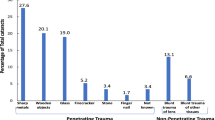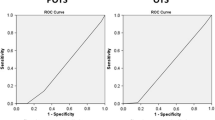Abstract
Background and objectives
This study aimed to investigate the impact of the possible prognostic factors for postsurgical success on visual acuity (VA) in traumatic cataract patients.
Materials and methods
The files of 92 patients (19 women[20.6%]–73 men[79.4%], 44 right–48 left total 92 eyes) who underwent surgery for traumatic cataracts between 2004 and 2018 were retrospectively reviewed for preoperative and final corrected distance VA(CDVA), laterality of trauma, time of admission to a hospital after trauma(TAH), type of injury, location of the injury (zone 1 [corneal], zone 2 [corneal and scleral], zone 3 [scleral]), additional ocular injury, simultaneous or secondary surgery, surgical cataract techniques, and complications.
Result
Of the 92 patients enrolled in the study, the mean CDVA was improved from preoperative 1.95 ± 0.49 logMAR to postoperative 0.73 ± 0.72 logMAR.(p < 0.001) In 36.7% of cases, the final CDVA was ≥ 20/40; it was ≥ 20/60 in 58.7%, ≥ 20/200 in 73.9%, and ≥ 20/400 in 94.5%. The strongest correlation was found between postoperative CDVA and preoperative CDVA (Pearson’s R = 0.969, p = 0.0001). No correlation was found between CDVA and age, sex, and laterality. The regression analysis showed a significant relationship between the increase in CDVA and TAH, trauma type and location, and surgical timing and techniques. The worst CDVA prognosis was found for patients with a zone 3 injury; patients with a zone 1 injury had the best prognosis. The prognosis is better for a closed globe injury than an open globe injury (p = 0.019). Early TAH was related to a better prognosis than later
admissions. No difference was observed between simultaneous and secondary surgeries (p = 0.413) and surgical techniques (p = 0.12).
Conclusion
Postoperative CDVA is better in traumatic cataract patients with a better preoperative VA. Early hospital admission after trauma, closed globe, and zone 1 injuries are better prognostic factors than late hospital admission time, open globe, and zone 3 injuries.
Similar content being viewed by others
References
Klopfer J, Tielsch JM, Vitale S, See LC, Canner JK (1992) Ocular trauma in the United States. Eye injuries resulting in hospitalization, 1984 through 1987. Arch Ophthalmol 110(6):838–842
Tielsch JM, Parver L, Shankar B (1989) Time trends in the incidence of hospitalized ocular trauma. Arch Ophthalmol 107(4):519–523
Abraham DI, Vitale SI, West SI, Isseme I (1999) Epidemiology of eye injuries in rural Tanzania. Ophthalmic Epidemiol 6(2):85–94
May DR, Kuhn FP, Morris RE, Witherspoon CD, Danis RP, Matthews GP, Mann L (2000) The epidemiology of serious eye injuries from the United States Eye Injury Registry. Graefes Arch Clin Exp Ophthalmol 238(2):153–157
Glynn RJ, Seddon JM, Berlin BM (1988) The incidence of eye injuries in New England adults. Arch Ophthalmol 106(6):785–789
Koval R, Teller J, Belkin M, Romem M, Yanko L, Savir H (1988) The Israeli Ocular Injuries Study. A nationwide collaborative study. Arch Ophthalmol 106(6):776–780
Dandona L, Dandona R, Srinivas M, John RK, McCarty CA, Rao GN (2000) Ocular trauma in an urban population in southern India: the Andhra Pradesh Eye Disease Study. Clin Exp Ophthalmol 28(5):350–356
Moreira CA Jr, Debert-Ribeiro M, Belfort R Jr (1988) Epidemiological study of eye injuries in Brazilian children. Arch Ophthalmol 106(6):781–784
Serrano JC, Chalela P, Arias JD (2003) Epidemiology of childhood ocular trauma in a northeastern Colombian region. Arch Ophthalmol 121(10):1439–1445
Wong TY, Klein BE, Klein R (2000) The prevalence and 5-year incidence of ocular trauma. The Beaver Dam Eye Study. Ophthalmology 107(12):2196–2202
Kuhn F (2010) Traumatic cataract: what, when, how Graefes. Arch Clin Exp Ophthalmol 248(9):1221–1223. https://doi.org/10.1007/s00417-010-1387-9
Trevor-Roper PD The eye and its disorders. 25. The lens. Int Ophthalmol Clin. 1974 Spring-Summer, 14(1–2):485–520
Kuhn F, Mester V (2002) Anterior chamber abnormalities and cataract. Ophthalmol Clin North Am 15(2):195–203 Review
Kwitko ML, Kwitko GM (1990) Management of the traumatic cataract. Curr Opin Ophthalmol 1(1):25–27 Review
Mian SI, Azar DT, Colby K (2002) Management of traumatic cataracts. Int Ophthalmol Clin. Summer, 42(3):23–31. (Review)
Shah M, Shah S, Shah S, Prasad V, Parikh A (2011) Visual recovery and predictors of visual prognosis after managing traumatic cataracts in 555 patients. Indian J Ophthalmol 59(3):217–222. https://doi.org/10.4103/0301-4738.81043
Kuhn F, Morris R, Witherspoon CD, Mester V. The Birmingham Eye Trauma Terminology system (BETT). J Fr Ophtalmol 2004; 27:206–210. https://www.em-consulte.com/showarticlefile/112778/pdf_57893.pdf. Accessed 2 Nov 2017
Shah M, Shah S, Upadhyay P, Agrawal R (2013) Controversies in traumatic cataract classification and management: a review. Can J Ophthalmol 48:251–258
Gradin D, Yorston D (2001) Intraocular lens implantation for traumatic cataract in children in East Africa. J Cataract Refract Surg 27(12):2017–2025
Hemo Y, BenEzra D (1987) Traumatic cataracts in young children. Correction of aphakia by intraocular lens implantation. Ophthalmic Paediatr Genet 8(3):203–207
Brar GS, Ram J, Pandav SS, Reddy GS, Singh U, Gupta A (2001) Postoperative complications and visual results in uniocular pediatric traumatic cataract. Ophthalmic Surg Lasers 32(3):233–238
Rumelt S, Rehany U (2010) The influence of surgery and intraocular lens implantation timing on visual outcome in traumatic cataract. Graefes Arch Clin Exp Ophthalmol 248(9):1293–1297. https://doi.org/10.1007/s00417-010-1378-x
Shah M, Shah S, Applewar A et al (2012) Ocular Trauma Score as a predictor of final visual outcomes in traumatic cataract cases in pediatric patients. J Cataract Refract Surg 38(6):959–965. https://doi.org/10.1016/j.jcrs.2011.12.032
Reddy A, Ray R, Yen K (2009) Surgical intervention for traumatic cataracts in children: epidemiology, complications, and outcomes. J AAPOS 13(2):170–174. https://doi.org/10.1016/j.jaapos.2008.10.015
Xu Y, Huang Y, Xie L (2013) Pediatric traumatic cataract and surgery outcomes in eastern China: a hospital-based study. Int J Ophthalmol 6(2):160–164. https://doi.org/10.3980/j.issn.2222-3959.2013.02.10
Shah MA, Shah SM, Gosai SR, Gupta SS, Khanna RR, Patel KB, Rathod CD (2018) Comparative study of visual outcome between open- and closed-globe injuries following surgical treatment of traumatic cataract in children. Eur J Ophthalmol 28(4):406–411. https://doi.org/10.1177/1120672117747021
Jinagal J, Gupta G, Gupta PC, Yangzes S, Singh R, Gupta R, Ram J (2019) Visual outcomes of pediatric traumatic cataracts. Eur J Ophthalmol 29(1):23–27. https://doi.org/10.1177/1120672118757657
Sharma AK, Aslami AN, Srivastava JP, Iqbal J (2016) Visual outcome of traumatic cataract at a tertiary eye care centre in North India: a prospective study. J Clin Diagn Res 10(1):05–8. https://doi.org/10.7860/JCDR/2016/17216.7049
Qi Y, Zhang YF, Zhu Y, Wan MG, Du SS, Yue ZZ (2016) Prognostic factors for visual outcome in traumatic cataract patients. J Ophthalmol 2016:1748583. https://doi.org/10.1155/2016/1748583
Esmaeli B, Elner SG, Schork MA, Elner VM (1995) Visual outcome and ocular survival after penetrating trauma. A clinicopathologic study. Ophthalmology 102(3):393–400
Yardley AM, Ali A, Najm-Tehrani N, Mireskandari K (2018) Refractive and visual outcomes after surgery for pediatric traumatic cataract. J Cataract Refract Surg 44(1):85–90. https://doi.org/10.1016/j.jcrs.2017.09.033
Tabatabaei SA, Rajabi MB, Tabatabaei SM, Soleimani M, Rahimi F, Yaseri M (2017) Early versus late traumatic cataract surgery and intraocular lens implantation. Eye (Lond) 31(8):1199–1204. https://doi.org/10.1038/eye.2017.57
Jacob S, Agarwal A, Agarwal A, Agarwal S, Patel N, Lal V (2003) Efficacy of a capsular tension ring for phacoemulsification in eyes with zonular dialysis. J Cataract Refract Surg 29(2):315–321
D'Eliseo D, Pastena B, Longanesi L, Grisanti F, Negrini V (2003) Prevention of posterior capsule opacification using capsular tension ring for zonular defects in cataract surgery. Eur J Ophthalmol 13(2):151–154
Ahmed II, Crandall AS (2001) Ab externo scleral fixation of the Cionni modified capsular tension ring. J Cataract Refract Surg 27(7):977–981
Author information
Authors and Affiliations
Corresponding author
Additional information
Publisher's Note
Springer Nature remains neutral with regard to jurisdictional claims in published maps and institutional affiliations.
Rights and permissions
About this article
Cite this article
Özbilen, K.T., Altınkurt, E. Impact of the possible prognostic factors for visual outcomes of traumatic cataract surgery. Int Ophthalmol 40, 3163–3173 (2020). https://doi.org/10.1007/s10792-020-01502-5
Received:
Accepted:
Published:
Issue Date:
DOI: https://doi.org/10.1007/s10792-020-01502-5




